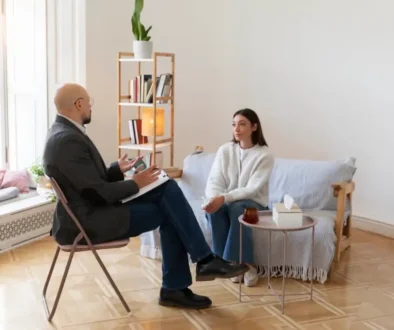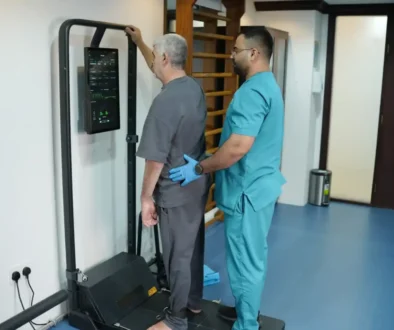Top 8 Precautions for Safer Post-Stroke Recovery at Home

Healing After a Stroke Starts With Awareness
Strokes can affect mobility, speech, memory, balance, even emotions. As the brain begins to recover, it’s rewiring itself with a process called neuroplasticity. But healing isn’t automatic. It needs your patience, consistency, and daily awareness to protect what’s healing and support what’s re-learning.
Without the right care and caution, there’s a higher risk of:
- Falls or injury due to weakness or poor balance
- Another stroke
- Delayed rehabilitation
- Emotional burnout or depression
- Medication mismanagement
That’s why post-stroke precautions aren’t about restrictions. They’re about protection. They help your body heal safer, smoother, and stronger.
1. Watch Your Steps
Balance is often compromised after a stroke. Even simple movements like standing up too fast or walking on uneven ground can lead to dangerous falls.
Self-Precautions You Can Take:
- Always wear non-slip footwear, even inside the house.
- Install handrails in the bathroom, staircases, and halls.
- Remove loose rugs, clutter, and sharp-edged furniture.
- Use a walking aid (like a cane or walker) as prescribed. Don’t push to go without it too soon.
- Sit down while dressing or doing tasks if your balance is still recovering.
Our physiotherapy and occupational therapy team can evaluate your home setup and suggest mobility aids tailored for you.
2. Know the Warning Signs of Another Stroke
After having one stroke, the risk of another is higher. Especially in the first year. But early action can save lives.
Keep an Eye On:
- Sudden numbness or weakness in face, arm, or leg (especially on one side)
- Trouble speaking or understanding speech
- Sudden vision changes in one or both eyes
- Loss of balance or dizziness
- Sudden severe headache with no known cause
Memorize FAST:
- Face drooping
- Arm weakness
- Speech difficulty
- Time to call emergency
Even if the symptoms go away quickly, call for help immediately.
3. Stick to Your Medications and Diet Plan
Your medicines, be it blood thinners, cholesterol reducers, blood pressure controllers, are all part of your protection. Missing doses or changing them without advice can be dangerous.
What You Can Do:
- Set daily alarms to take your meds.
- Keep a checklist or pill organizer.
- Avoid high-salt, high-sugar, and fatty foods.
- Drink enough water. Dehydration can affect recovery and cause confusion or fatigue.
Our team provides customized post-stroke dietary plans and medication management support, so you’re never guessing what’s safe to eat or skip.
4. Move Gently, But Don’t Stop Moving
Inactivity slows down stroke recovery. But overexertion without guidance can backfire. The balance lies in guided, safe movement.
Do:
- Practice your daily physiotherapy routine.
- Do gentle stretching each morning.
- Use your affected limb as much as possible (even if slowly).
- Practice walking short distances every day.
Don’t:
- Rush to resume old routines (driving, lifting heavy items, etc.)
- Compare your progress to others. Every brain heals at its own pace.
Our physiotherapists use techniques like LSVT BIG and neuro-rehab movement patterns to help rebuild strength in stroke survivors.
5. Mental Health Is Part of Recovery
Stroke can lead to emotional changes like sadness, frustration, anxiety, or even post-stroke depression. That doesn’t mean you’re weak. It means your brain has been through trauma and is healing.
Your Precaution:
- Talk about how you feel. With your therapist, your loved ones, or a counselor.
- Practice mindfulness or breathing exercises.
- Don’t isolate yourself.
- Ask your healthcare team for support if you feel emotionally overwhelmed.
Our psychologists and behavioral therapists provide stroke-specific emotional care, helping you rebuild not just speech and strength but hope.
6. Speech and Swallowing Needs Attention Too
Strokes often affect communication and swallowing. If you’re finding it hard to speak clearly, understand others, or swallow without coughing, do not ignore it.
Precautions for Safer Eating & Speaking:
- Sit upright while eating and for 30 minutes after.
- Avoid talking while chewing.
- Stick to recommended food textures (soft, thick liquids if needed).
- Use speech therapy exercises daily, even if just for 10 minutes.
Our speech-language therapists offer personalized rehab sessions and home exercises to help regain voice and confidence.
7. Don’t Skip Checkups!
Stroke recovery isn’t linear. You may feel good for weeks and then hit a wall. That’s normal. But don’t skip your check-ins or therapy sessions just because things seem okay.
Keep Up With:
- Monthly follow-ups with your neurologist
- Regular physiotherapy reviews
- Blood pressure and sugar monitoring
- Brain scans if advised
8. Involve Your Family or Caregiver
You don’t have to do it alone. Involving someone in your recovery journey helps:
- Remind you about meds and appointments
- Notice warning signs you might miss
- Support you emotionally during hard days
- Help you stay motivated and active
What Kent Healthcare Offers for Post-Stroke Recovery
At Kent Healthcare, your recovery isn’t treated like a checklist. It’s a conversation. We provide:
- Neurological physiotherapy sessions
- Occupational therapy for hand and daily task recovery
- Swallowing and speech therapy
- Psychology and emotional support
- Stroke education and caregiver training
- Home exercise guidance and fall-prevention tips
- LSVT BIG movement therapy
- Follow-up and progress tracking reports
Everything is done under one roof. With one goal: getting you back to a life that feels like yours again.
Let’s Recover Together
Stroke doesn’t mean the end of movement, voice, or independence. With the right precautions, support, and daily choices, healing is not just possible but it can be powerful.
You’ve already survived the hardest part. Let us help you recover in what comes next. Book a post-stroke consultation at Kent Healthcare today. Let’s rebuild your strength, balance, and life.
Book an appointment
Booking an appointment with our team of professionals is just a few taps away. Book now!


